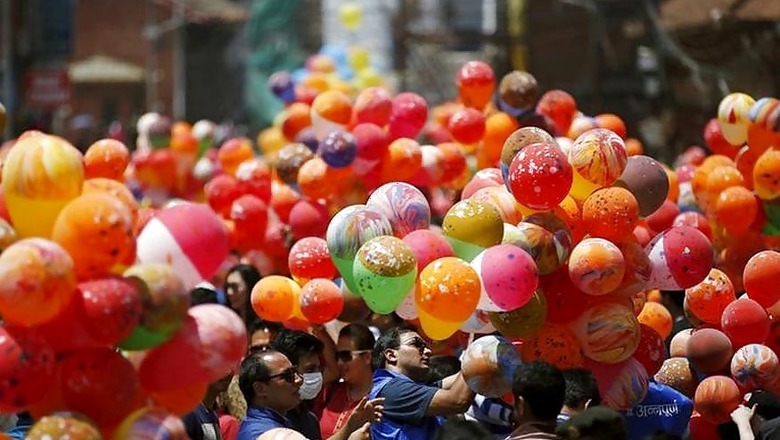
views
Kathmandu: Hundreds of Nepalese on Sunday held memorial services to mark the first anniversary of 2015 devastating earthquake that killed nearly 9,000 people, as victims still forced to live in tents accused the government of failing to look after them.
Prime Minister K P Sharma Oli laid flowers at the demolished 19th-century Dharahara tower where people gathered to pay homage to those killed when the 7.9-magnitude temblor struck, after a minute's silence to remember the deceased.
Though the quake jolted Nepal on April 25, 2015, the memorials were being held on Sunday in its grim reminder as per the Bikram Era calendar. The quake was extremely devastating for the land-locked Himalayan nation, displacing lakhs of families besides putting a huge dent in the country's economy.
Oli paid tribute to those killed in the earthquake, wishing for the eternal peace of the departed souls as he said the government is distributing eligibility certificates to the 31,19,000 affected people to enable them to avail promised grants to rebuild their houses.
"The government was committed to providing safe shelter to the earthquake survivors by the rainy season. The government was raising temporary community settlements for the difficulty time in view of the coming rainy season," Oli said.
He expressed his government's commitment to accelerate the reconstruction activities, and assured of speedy distribution of relief amount with assistance on designs and mapping for the reconstruction of safe and quake-resistant houses in the quake-hit districts.
"As we have a very few artisans well-versed in woodcrafts, we need to train more people to reconstruct the quake-damaged infrastructures in their original design," he noted.
Shortly after the quake, that killed nearly 9,000 people, the government had promised to pay USD 1,850 (around 2 lakh Nepali rupees) to each family whose houses were damaged. The quake and aftershocks that hit central Nepal, including Kathmandu, also injured 22,000 others.
Ramesh Shrestha, whose house was demolished in the quake, said: "I am scared if my family will get compensation at all. It has already been a year."
Around 8,00,000 houses including hundreds of school buildings had collapsed due to the twin earthquakes of April 25 and May 12 that hit as many as 14 districts of Nepal. Some four million survivors are still living in temporary shelters, according to the International Federation of Red Cross and Red Crescent Societies.
Oli reached the earthquake-devastated site at Dharahara that was completely damaged by the earthquake, amid a programme organised in commemoration of the great earthquake. A procession led by Nepalese Tourism Minister Ananda Pokharel took round of the city before converging into a gathering at the Dharahara site.
Buddhist monks in maroon robes held prayers at Swyambhunath Stupa that was home to a popular temple destroyed in the quake.
A small group of about 20 protesters dressed in black took to the streets, chanted "politicians in palaces, public in tents" and "what happened to reconstruction?". Police quickly removed their banner but allowed them to shout anti-government slogans.
On one hand, the people of 14 earthquake-hit districts are still living under fear of a recurrence while on the other, the government's reconstruction and recovery work is progressing at a snail's pace.
A 4.2-magnitude aftershock hit central Nepal this morning as the country was marking the first anniversary of the devastating earthquake. The epicentre of the earthquake, that was felt in Kathmandu too, was located in Nuwakot district, 125 kms west.
With this, a total of 450 aftershocks with 4 or more magnitude have been recorded after the great earthquake. The earthquake badly hit the country's tourism and caused an economic loss of USD 7 billion. According to the Asian Development Bank, growth is now expected to reach just 1.5 per cent over the financial year ending in July this year - the lowest since 2007.
Although international donors pledged USD 4.1 billion financial assistance to help Nepal's post quake recovery, the reconstruction and rehabilitation works have been moving at a very slow pace due to the political wrangling in forming the National Reconstruction Authority among the major political parties.
The government had promised to distribute a lump sum of Rs 2,00,000 to those whose houses were completely damaged by the quake, However, very few people have received the relief money.
During the last winter, many quake survivors in the mountainous districts of the country were forced to spend the nights under small tents with not enough food and clothing. Days after the April 25 quake, a second temblor struck Nepal, adding to its woes.
The first earthquake of 7.9-magnitude with epicentre at Gorkha district, 150 kms west of Kathmandu, hit the country on Baishakh 12 of the year 2072 Bikram Era (April 25) and the second quake with 7.3-magnitude hit on Baishakh 29 or May 12 with epicentre at Kodari Highway in Nepal-Tibet border, 120 kms east of Kathmandu.
Nepal has experienced two great earthquakes in the past 180-year period before last year's temblor which has been dubbed as the 'Gorkha quake'.
The last 'great' earthquake that hit the country in 1934 with its epicentre at Sankhuwasabha in eastern Nepal, which also gave a big jolt to Kathmandu, killed 8,519 people, according to historical data.
A hundred years before, in 1833, a similar over 7.8- magnitude earthquake hit central Nepal and the nature of last year's temblor is close to that of this quake, say experts.




















Comments
0 comment